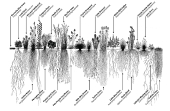Thomas,
Soil isn't actually magic. But for all practical purpasses it is.
A few simple things you can do to start coming to terms with dirt.
1) Dig it! Go get a trowel or digging knife and scope some up! I cant explain it - but get a good tactile sense of it. use your nose. use your eyes. You can probably rock out on headphones and not miss to much about what goes on underground...
There are three main components in soil other than Organic Matter (OM). Sand, silt, and Clay. They fall into a pretty triangle.
http://www.oneplan.org/Water/soil-triangle.asp
Get it wet. Make some balls. Play with it. Stretch it out. When you first break it open look and see how many 'aggregates' there are. Little balls of soils. Chunkyness.
2) Put a scope of soil into a couple cups of water (like a mason jar) shake it up and let it settle. This will stratify your soil and let you see whats what. I leave in roots - that's organic matter just waiting to integrate into your soil.
3) Do a field capacity test. All you need is a watch, a shovel, some water, and a sheet of plastic wrap. Dig a whole. saturate your soil. Put in the plasic wrap. fill hole. start watch. remove plastic. Wait to drain.
http://en.wikipedia.org/wiki/Field_capacity
4) there are instruments out their called 'penetrometers' (insert joke here) used to measure compaction. It will give you a pretty number. If you're cheep just use a piece of rebar and get all subjective with it.
So there's a few things you should be able to walk out of your door and door at you're leisure








